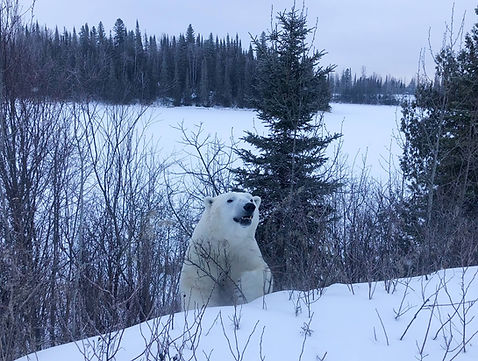
Conservation
The Cochrane Polar Bear Habitat regularly collaborates with conservation and research institutions from within Canada and Internationally. Our shared goals are to learn more about polar bears and how we can care for them, both in human care and in the wild.
All studies are either non-invasive, or the bears can voluntarily take part if they choose to. This allows researchers to gain the most accurate information whilst maintaining the highest standard of welfare for our bears.

Drone footage courtesy of the National Oceanic and Atmospheric Administration
(click on image to expand)

Conservation
at the Polar Bear Habitat
The conservation of polar bears requires a multi-faceted approach. Both in-situ (studying animals in their natural environment) and ex-situ (studying animals out of their natural environment, like in a zoo or aquarium) projects are essential in learning all we can about polar bears, and how to protect them and the arctic ecosystem.
At the Polar Bear Habitat, we provide support to researchers looking at studying polar bears in an ex-situ setting. Polar bears in human care play a vital role in conservation, as they allow researchers to gain longitudinal data (data collected from the same animal over a long period of time) which is almost impossible to do in the wild due to the extensive size their home range covers. All studies we participate in are either non-invasive, or the bears are given the choice to participate or not.
Education plays a vital role in the conservation of polar bears and the arctic environment. While it may feel like polar bears live so far away from most people that there is no way our actions can affect them, this is just not the case. Human-caused climate change is the largest threat to polar bears, with rapidly warming temperatures causing significant sea ice loss across the arctic. The choices that people make in their everyday lives can have a meaningful impact on the rate at which arctic warming is occurring by reducing their carbon footprint. These choices do not require us to change our entire way of life, even the smallest of changes can have a large impact when we all come together.


How does climate change affect polar bears?
Polar bears rely on sea ice to survive. Sea ice provides them with a platform from which to hunt and travel, find mates to reproduce, and sometimes even to den. Climate warming, caused by an excess of heat trapping gasses around the planet, affects the thickness and extent of arctic sea ice. With less sea ice in some areas of the arctic, a polar bears’ ability to hunt for its main prey, seals, becomes increasingly difficult. With limited access to food, polar bear populations in these areas have begun to decline.
Less access to sea ice is also increasing the potential for human-bear conflict. As the ice-free period increases each year, bears are being forced onto land for longer periods of time. During this time, in which they would normally hunt seals from the sea ice, some bears will begin to look for alternate food sources on land. A polar bears’ strong sense of smell may bring them close to human settlements, which may result in conflict, as they look for food sources such as hunted meat or garbage. It is imperative to understand that polar bears do not hunt humans as prey. While fatalities have occurred, they are extremely rare, and more often than not, it is the bear that loses its life.
Partnership with
Polar Bears International
We are proud to be an Arctic Ambassador Centre (AAC) for Polar Bears International, a world leader in polar bear research and education. We work collaboratively with Polar Bears International to amplify their reach and support research, education and action programs, all aimed at protecting polar bears. As an Arctic Ambassador Centre, our staff are given the opportunity to participate in the Climate Alliance Program. This program provides valuable training on effective public outreach and education, and builds connections with fellow AAC network members. Best of all, this program takes place in Churchill, Manitoba, where our staff get the opportunity to experience first hand the arctic ecosystem and work directly with the staff at Polar Bear International.
Please visit their website (here) to learn more about our partnership and the value work carried out by Polar Bears International.


Inukshuk eating a sample of seaweed
Polar Bear Habitat Research Contributions
Over the past 20 years, we have been involved in a number of different studies conducted by researchers and PhD students from across North America.
Click the links below to read the published studies!
Research Papers
Burr on Fur
Seaweed Diet Study
Distinct fecal microbiome between wild and habitat-housed captive polar bears (Ursus maritimus): Impacts of captivity and dietary shifts
Henry's Hormone Study
Testosterone concentrations in juvenile male polar bears (Ursus maritimus)


